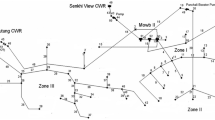Abstract
A transition from the mass balance equations based on Kirchhoff’s first and second laws to modeling on the basis of a discretized continuity equation is made for describing a hydraulic network. A technique for calculating high-dimension hydraulic and heat networks based on the numerical finite-difference control volume method is developed. Unlike the existing approaches, the proposed technique does not involve the need to determine hydraulic loops and boils down to solving the problem of obtaining a unified field of pressures for the entire calculation region. This advantage of the proposed method opens the possibility of applying it for solving high-dimension problems containing more than a million of hydraulic links. The proposed numerical method features stable operation for hydraulic networks the neighboring links of which may have pressure drop coefficients differing from each other by more than 10 orders of magnitude. In contrast, the global gradient algorithm implemented in the standard software system EPANET is of little use for such applications. The convergence rate of the proposed technique is close to that of the Todini gradient algorithm and is almost independent of the problem dimension.
Similar content being viewed by others
References
Kh. A. Alimov, “Heat networks. Topical problems and ways for solving them,” http://www.rosteplo.ru/Tech-stat/stat-shablon.php?id=2491.
V. M. Lipovskikh, “Main ways for achieving energy efficiency during heat network operation,” Energosber., No. 1, 10–12 (1999).
Russian heat networks: Problems and solutions,” http://www.kiranna.by/information/publications/438.html.
B. G. Waanders van Bloemen, “Application of optimization methods to calibration of water distribution systems,” 10 (2006).
A. P. Merenkov, K. S. Svetlov, V. G. Sidler, and V. Ya. Khasilev, “A so-called mathematical flow meter and its application in heat networks,” Teploenergetika, No. 1, 70–72 (1971).
A. Ostfeld, J. G. Uber, E. Salomons, J. W. Berry, W. E. Hart, C. A. Phillips, J.-P. Watson, G. Dorini, P. Jonkergouw, Z. Kapelan, F. di Pierro, Soon-Thiam Khu, D. S. D. Eliades, M. Polycarpou, S. R. Ghimire, B. D. Barkdoll, R. Gueli, J. J. Huang, E. A. McBean, W. James, A. Krause, J. Leskovec, S. Isovitsch, Jianhua Xu, C. Guestrin, J. Van Briesen, M. Small, P. Fischbeck, A. Preis, M. Propato, O. Piller, G. B. Trachtman, Z. Yi Wu, and T. Walski, “The battle of the water sensor networks (BWSN): A design challenge for Engineers and Algorithms,” J. Wat. Res. Plan. Manag., 556–568 (2008).
A. P. Merenkov and V. Ya. Khasilev, Heat Network Calculation Methods and Algorithms (Energiya, Moscow, 1978) [in Russian].
A. P. Merenkov and V. Ya. Khasilev, Theory of Hydraulic Networks (Nauka, Moscow, 1985) [in Russian].
E. Todini and S. Pilati, “A gradient method for the analysis of pipe networks,” in Proceedings of the International Conference on Computer Applications for Water Supply and Distribution, Leicester Polytechnic, UK, 1987.
L. A. Rossman, EPANET 2, Users Manual. (Water Supply and Water Resources Division National Risk Management Research Laboratory, Cincinnati, OH, 45268, September 2000).
S. V. Patankar, Numerical Heat Transfer and Fluid Flow (Taylor and Francis, 1981).
S. F. Glebov, D. V. Makarov, A. P. Skibin, and V. P. Yugov, “Applying a combined mesh for numerically solving 3D hydrodynamics and heat transfer using the control volume method,” Inzh. Fiz. Zh. 71(4), 740–745 (1998).
E. Todini, “On the convergence properties of the different pipe network algorithms,” in Proceedings of the 8th Annual Water Distribution Systems Analysis Symposium, Cincinnati, Ohio, the United States, 2006.
K. V. Loginov, “Modeling of complex hydraulic systems with controlled parameters,” Informatika, Inf. Sist, No. 3 (24), 17–22 (2004).
Author information
Authors and Affiliations
Corresponding author
Additional information
Original Russian Text © V.Yu. Volkov, A.A. Krutikov, A.V. Nikolaeva, A.P. Skibin, 2014, published in Teploenergetika.
Rights and permissions
About this article
Cite this article
Volkov, V.Y., Krutikov, A.A., Nikolaeva, A.V. et al. Development of a method for calculating high-dimension heat networks. Therm. Eng. 61, 836–843 (2014). https://doi.org/10.1134/S0040601514110123
Published:
Issue Date:
DOI: https://doi.org/10.1134/S0040601514110123




